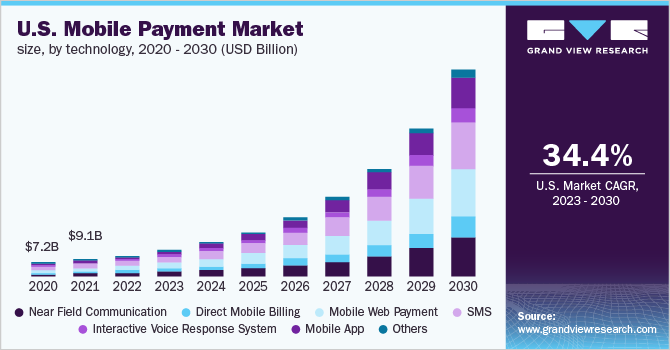The landscape of financial transactions has undergone a radical transformation in recent years. The rise of US mobile payments has revolutionized how we pay for goods and services, offering convenience, security, and speed. This comprehensive guide delves into the world of US mobile payments, equipping you with the knowledge to navigate various payment methods, understand their functionalities, and leverage them for a seamless and secure payment experience.
Understanding US Mobile Payments
US mobile payments encompass a broad range of methods that utilize your smartphone or mobile device to facilitate cashless transactions. These methods can be broadly categorized into two main groups:
- Contactless Payments:These methods involve physically tapping your phone or mobile device against a contactless reader at a point-of-sale terminal. This technology employs near-field communication (NFC) to transmit payment information securely.
- Digital Wallets:Digital wallets store your payment credentials like credit card or debit card information on your mobile device. You can access these wallets through dedicated apps to make secure online payments or in-app purchases without manually entering card details.

Popular US Mobile Payment Methods
Several popular US mobile payment methods offer a variety of features and functionalities:
- Apple Pay:A built-in mobile payment solution exclusive to Apple devices. Apple Pay utilizes NFC for contactless payments and integrates seamlessly with Apple Watch for on-the-go transactions.
- Google Pay:An open-source mobile payment platform compatible with various Android devices and operating systems. Google Pay utilizes NFC for contactless payments and also facilitates online and in-app purchases.
- Samsung Pay:A pre-installed mobile payment solution available on most recent Samsung Galaxy smartphones and smartwatches. Samsung Pay employs NFC and Magnetic Secure Transmission (MST) technology, allowing for wider compatibility with older point-of-sale terminals.
- Carrier Billing:This method allows you to add mobile payment charges directly to your monthly phone bill. While convenient, carrier billing often incurs additional fees.
Benefits of Using US Mobile Payments
US mobile payments offer numerous advantages over traditional cash and card transactions:
- Convenience:Eliminate the need to carry cash or fumble with physical cards. Mobile payments are readily available on your phone, making transactions faster and easier.
- Security:Mobile payment systems typically incorporate robust security features like tokenization and encryption to safeguard your financial information.
- Transaction Tracking:Most mobile payment apps provide detailed transaction history, allowing you to easily monitor your spending habits.
- Rewards and Incentives:Certain mobile payment platforms offer rewards programs or cashback benefits for using their services.
Security Considerations for US Mobile Payments
While mobile payments offer convenience, security remains paramount. Here are some crucial considerations:
- Utilize Strong Passwords and Biometric Authentication:Set strong passwords or PINs for accessing your mobile payment apps and utilize biometric authentication features like fingerprint or facial recognition for an extra layer of security.
- Download Apps from Official Stores:Only download mobile payment apps from official app stores like Google Play or the Apple App Store to minimize the risk of malware.
- Report Lost or Stolen Phones Immediately:If your phone is lost or stolen, notify your mobile carrier and mobile payment service providers immediately to prevent unauthorized transactions.
- Beware of Public Wi-Fi:Avoid using public Wi-Fi networks when making mobile payments, as these networks might be vulnerable to interception.
The Future of US Mobile Payments
The landscape of US mobile payments is constantly evolving. Here’s a glimpse into what the future might hold:
- Biometric Authentication Advancements:Fingerprint and facial recognition technologies are likely to become even more integrated into mobile payments, further enhancing security and convenience.
- Blockchain Integration:Blockchain technology has the potential to revolutionize mobile payments by creating a secure and decentralized system for transactions.
- Rise of Contactless Payment Methods:NFC-based contactless payments are expected to become even more ubiquitous, making mobile payments the norm for everyday transactions.
Choosing the Right US Mobile Payment Method
The ideal US mobile payment method depends on your individual needs and preferences. Here’s how to make an informed decision:
- Compatibility:Ensure your chosen mobile payment method is compatible with your smartphone and operating system.
- Security Features:Prioritize platforms that offer robust security features and utilize strong authentication protocols.
- Rewards and Incentives:Consider any rewards programs or cashback benefits offered by different mobile payment providers.
- Frequency of Use:If you plan to use mobile payments frequently, prioritize a method that is widely accepted at your preferred stores and online merchants.
Conclusion
US mobile payments represent the future of cashless transactions, offering a convenient, secure, and efficient way to pay. This guide empowers you to understand the various payment methods available, navigate the evolving landscape, and choose the US mobile payment solution that best suits your requirements. With a growing number of options and continuous advancements, mobile payments are poised to become an indispensable part of our financial ecosystem. As technology progresses, so too will the security features and functionalities of these platforms, ensuring a seamless and secure payment experience for all.
Sources:
- Federal Reserve Bank of Cleveland – How Mobile Payments Work.
- Consumer Financial Protection Bureau – Mobile Payments: [[invalid URL removed]]
- The Pew Research Center – US Smartphone Use in 2021: [[invalid URL removed]]
- Apple – About Apple Pay.
- Google – About Google Pay.
- Samsung – What is Samsung Pay?: [[invalid URL removed]]
Additional Considerations
- Privacy Concerns:While mobile payment platforms prioritize security, be mindful of data collection practices and privacy policies associated with each service.
- Emerging Technologies:Explore emerging mobile payment technologies like wearable payments using smartwatches or contactless payment rings for an even more futuristic experience.
- Financial Inclusion:As mobile payments become more prevalent, ensure accessibility for all demographics through user-friendly interfaces and support for various mobile devices.
By leveraging the knowledge gleaned from this comprehensive guide and staying informed about advancements in US mobile payments, you can embrace the convenience and security this technology offers while making informed decisions about managing your finances in the digital age. Remember, responsible usage and a security-conscious approach are key to maximizing the benefits of mobile payments and navigating the ever-evolving financial landscape.
لا تعليق